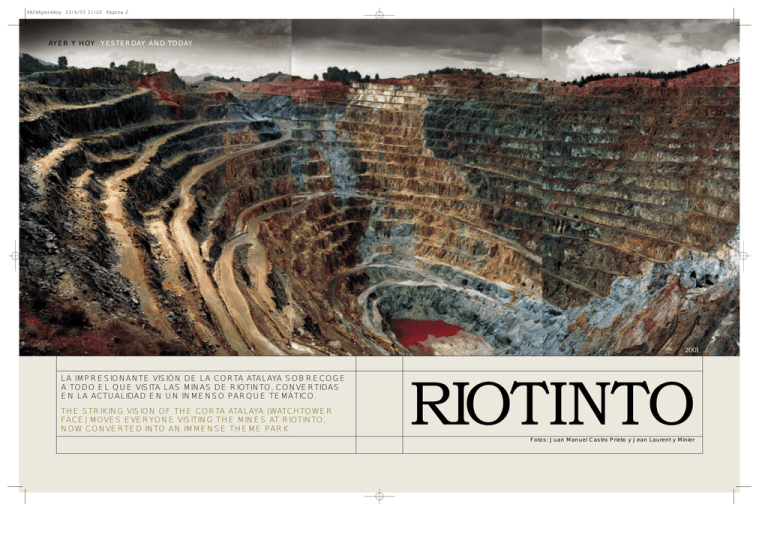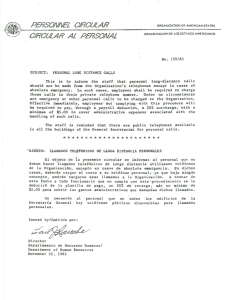la impresionante visión de la corta atalaya sobrecoge a todo el que
Anuncio

PA04Ayer&Hoy 23/4/03 11:20 Página 2 AYER Y HOY YESTERDAY AND TODAY 2001 LA IMPRESIONANTE VISIÓN DE LA CORTA ATALAYA SOBRECOGE A TODO EL QUE VISITA LAS MINAS DE RIOTINTO, CONVERTIDAS EN LA ACTUALIDAD EN UN INMENSO PARQUE TEMÁTICO. THE STRIKING VISION OF THE CORTA ATALAYA (WATCHTOWER FACE) MOVES EVERYONE VISITING THE MINES AT RIOTINTO, NOW CONVERTED INTO AN IMMENSE THEME PARK. RIOTINTO Fotos: Juan Manuel Castro Prieto y Jean Laurent y Minier PA04Ayer&Hoy 23/4/03 11:20 Página 4 AYER Y HOY YESTERDAY AND TODAY Era una época de esplendor para las Minas de Riotinto (Huelva), en manos británicas desde 1873. El traqueteo de los ferrocarriles que transportaban cobre hasta la ciudad resonaba en el interior de la Tierra en la zona de Filón Sur. Jean Laurent y Minier, fotógrafo nacido en 1816 en Nevers (Francia) y afincado en Madrid desde 1857, plasmaba así la inmensidad de este paisaje. Por aquel entonces, Laurent había reunido ya 5.000 instantáneas de España y Portugal, en las que los registros de la tradición se mezclaban con los signos de la modernidad. Cinco lustros después de esta foto, Riotinto comenzaría a explotar la Corta Atalaya. Sus 1.200 metros de largo, 900 de ancho y 335 de profundidad hicieron de ella la mina a cielo abierto más grande de Europa. 1882 It was a time of splendour for the Mines at Riotinto (Huelva), under British management since 1873. At the South Lode, the clackety-clack of the trains transporting copper to the city echoed deep in the heart of the Earth. This is how Jean Laurent Minier, a photographer born in Nevers (France) in 1816 but based in Madrid since 1857, portrayed the immensity of this landscape. Laurent had already amassed 5,000 photographs of Spain and Portugal, snapshots in which traditional elements were combined with signs of modernity. Twenty-five years after this photo was taken, Riotinto was to start its mining operations on the Corta Atalaya. Measuring 1,200 metres long, 900 metres wide and 335 metres deep, it became Europe's largest open-cast mine. 1882 1882 La Corta Atalaya es un oasis de irrealidad en medio de las Minas de Riotinto. La cuenca se ha convertido en un gran parque temático con un museo, un ferrocarril, un antiguo pueblo inglés... Pero en la Corta lo único que se oye es el silencio. Ni el paso del tiempo ni las visitas de los turistas han disipado el soplo de magia que envuelve a quien se asoma a su abismo. Quizá el misterio se encuentre en esa profundidad de la que da idea un viejo tren que en la lejanía se ve minúsculo. O puede que esté en sus tonos rojos, violetas, ocres... en esas pinceladas de color que se mezclan y se superponen de forma casi imposible en la fotografía de la página anterior. Su autor, Juan Manuel Castro Prieto (Madrid, 1958), ha mirado de un modo diferente un paisaje que habían contemplado millones de ojos antes. Fotografías como esta y como otras en blanco y negro, especialidad en la que es considerado el mejor profesional español, le han hecho merecedor de importantes galardones entre los que se encuentra el Bartolomé Ros (1991). Uno de sus trabajos más destacados es el libro ‘Perú, viaje al sol’ (Lunwerg Ed.), que deslumbró en Photoespaña 2001. 2001 The Corta Atalaya is an oasis of unreality in Riotinto Mines. The entire site has been turned into an enormous theme park with a museum, a railway line, an old English village... But all there is to hear at the Face is silence. Neither the time nor the visiting tourists have dissipated the air of magic embracing anyone looking out into the chasm. Perhaps the mystery lies in the depths, an idea of which can be gleaned from the elderly train looking like a toy in the distance. Or maybe it lies in the hues of red, violet, ochre... in those strokes of colour almost impossibly intermingled and superimposed in the photograph on the previous page. Its creator, J. M. Castro Prieto (Madrid, 1958), has looked differently on a landscape viewed by millions of eyes before him. Photographs such as this as well as others in black and white, a speciality in which he is considered to be the best professional in Spain, have earned him awards including Bartolomé Ros Prize (1991). One of his most outstanding works is his book ‘Perú, viaje al sol’ (‘Peru, journey to the sun’, published by Lunwerg Ed.), which stunned visitors to Photoespaña 2001 exhibition. 2001









